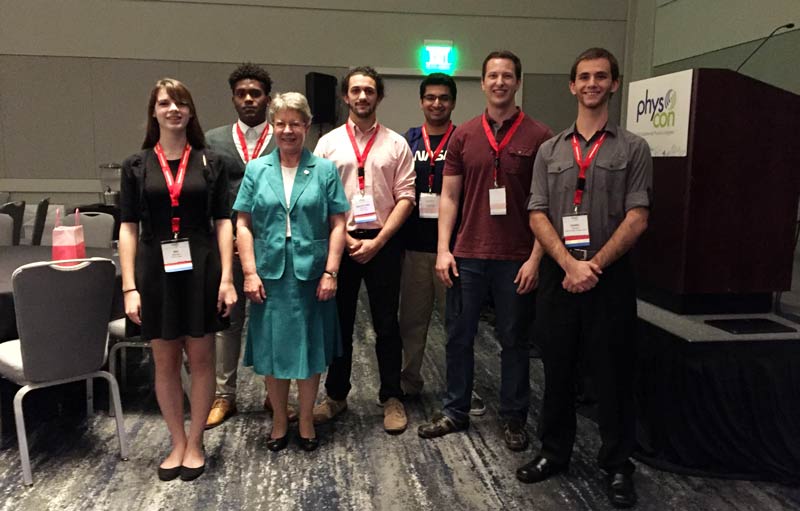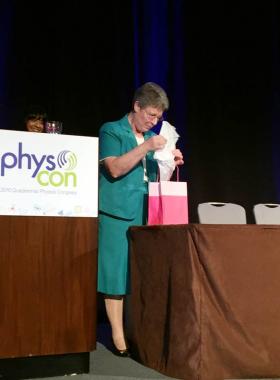An opening speech, an insightful talk, and an in-depth interview with the physicist
Sigma Pi Sigma Physics Congress (PhysCon)
November 3, 2016 to November 5, 2016
San Francisco, CA
Meeting host: By:Daniel Hooker, Cody Hughson, and Gobind Puniani
SPS Chapter:

Jocelyn Bell Burnell, Honorary Congress Chair of SPS and one of several speakers at the 2016 Quadrennial Physics Congress, pioneered the study of pulsars with her groundbreaking discovery of the very first one in 1967. She has since accomplished so much more, including enabling the flow of scientific knowledge to a more diverse student body.
In her talk, “Cosmic Fireworks – Finding Transient Events in the Universe”, Dr. Burnell discussed new technologies that allow astronomers to detect short duration phenomena. She also discussed her work in discovering pulsars.
We now know, thanks to her, that a pulsar is a rapidly rotating neutron star. When she first observed a pulsar in 1967, Dr. Burnell thought that the phenomenon might have been caused by a faulty piece of equipment. After all, she built the telescope herself while she was in graduate school. She advised, “If you observe a phenomenon, do not jump to the remarkable conclusions right away.” She urged us to take our time for checking the “usual suspects” behind anomalies before we make a statement about a discovery, a piece of advice that has served her well in her career.
Dr. Burnell went on to talk about how her best moment in her career was not the initial discovery of a pulsar, but rather the discovery of the second pulsar. The second observation officially proved the existence of pulsars, or, as she explained, “After I found the second one, I knew I had something.” Once it was confirmed that the observations were consistent and accurate, Dr. Burnell and her colleagues had to determine the cause behind the radio signals. She said that figuring out that the source was a rotating neutron star was not obvious; everyone had to think deeply to eliminate the other options and arrive at the final conclusion.
This accidental finding won her research advisers (Anthony Hewish and Martin Ryle) the Nobel Prize in Physics, while Dr. Burnell was not credited by the Nobel Prize committee. Dr. Burnell graciously accepted the decision, although many other prominent figures within the scientific community contested on her behalf.
Since her youth, science has made significant progress in welcoming to all types of people, especially women. Although there is still some work left for the scientific community in reducing the barriers to entry, Dr. Burnell said she is proud to know that we no longer contend with the ugly segregation that once plagued scientific education.
As a young girl, she was shocked to see girls dismissed into a “Home Science” class when only males had the exclusive privilege to a proper science course. While completing her thesis at Cambridge University, Dr. Burnell was the only woman in many of her classes. Surprisingly, she found that it was other women who denigrated her for her ambitions of transcending strict gender roles. Her years spent teaching at Open University, an educational institution in Britain for non-traditional students, further cemented her role in welcoming many types of students to physics. .
 When we interviewed Dr. Burnell, we were pleasantly surprised to find that such a well-regarded physicist was so humble and down-to-earth. We asked her how scientists should behave in order to maintain an attitude like hers that enables scientific researchers to engage with the general public.
When we interviewed Dr. Burnell, we were pleasantly surprised to find that such a well-regarded physicist was so humble and down-to-earth. We asked her how scientists should behave in order to maintain an attitude like hers that enables scientific researchers to engage with the general public.
Dr. Burnell replied with some wisdom for future scientists that attended this conference: “One of the things you have to be able to say as a research scientist is ‘I don’t know.’ You have to be able to live with ambiguities and uncertainties. One of the risks as scientists is to be too confident in your knowledge.” It is important for us physicists to never allow pride to interfere with the proper scientific method.
Dr. Burnell has previously stated that people often find her religious affiliation surprising, considering her advanced scientific pedigree. When asked how she reconciles her scientific mindset with her religious beliefs, she stated that her devotion to Quakerism does not interfere with her astronomy research. This religion does not require her to sacrifice her scientific views, since Quakerism encourages its followers to discover the world for themselves.
Many students who attended Dr. Burnell’s lecture, ourselves included, struggle from time to time in physics classes or in our work outside of school. When we asked Dr. Burnell what she would say to students who find themselves struggling in physics or other aspects of their lives her response was very humble and relatable. Everyone struggles at some point, she said. “I myself had difficulty in electromagnetism but you have to keep struggling through it, find the right books, work hard, and don’t give up too quickly.”
PhysCon gave over 1,200 physics students and professors a setting for a free, open exchange of ideas between people of varying backgrounds and interests who otherwise would not have met. There were many opportunities to network with both scientists and other physics students. In a short matter of time, the students befriended here will become our colleagues as we collaborate to solve some of the challenges currently facing society (not just in physics). Being that physics is a relatively small community, it is important for all of us to begin forging connections now. As Dr. Burnell observed, “The important thing to take away is the contacts you have made; the networking is really important.”